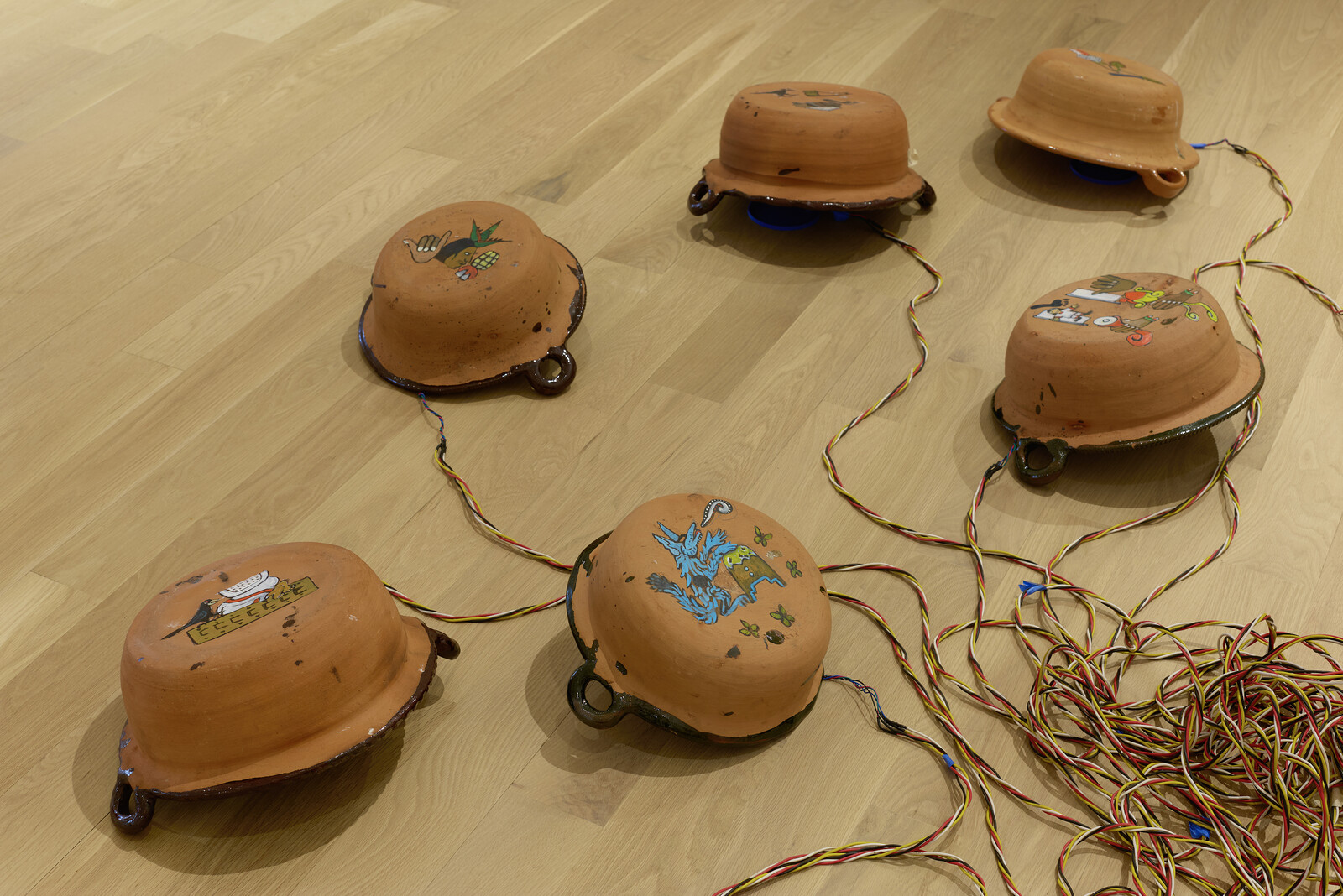When I first visited the wall between Mexico and the US in Patagonia, Arizona, in 2017, the town was celebrating: the redevelopment of a large patch of agricultural land had been halted due to the discovery of traces left by a jaguar. In one dramatic appearance, the endangered animal had accomplished what land activists had been trying to do for years. In this same spirit, Fernando Palma Rodríguez’s work plays on the symbiotic relationship between nature and technology, hinting at the possibility of alliance between animals, machines, and humans in the interest of anti-capitalist resistance. Rodríguez is an artist trained as a mechanical engineer whose 1994 robotic installation, Greetings, Zapata Moles—sewing machines adorned with traditional Mexican wrestling masks—responded to the industrialization of his hometown. Rodríguez’s latest robotic work likewise anthropomorphizes technological objects while extending the definition of technology to include unspoken, embodied forms of knowledge that sustain the living practices of Mesoamerican cultures, with particular reference to the Nahua cosmology.
At Canal Projects, Rodríguez draws parallels between the energetic currents that power physical, electronic, and metaphysical grids, and the cosmogenic principles that tie humans to the earth. “Āmantēcayōtl: And When it Disappears, it is Said, the Moon has Died” tells the complex story of a cornfield situated on the slopes of the Teuhtli Volcano in Milpa Alta, Mexico, where the artist was born. A breezy, rustling sound accompanies the kinetic sculptures: several rudimentary, endearing robotic animals dressed with dry corn husks, their cardboard, snaggle-toothed faces painted red, blue, black, and yellow. Shuffling back and forth, they symbolize the cardinal winds—fittingly, as several figures are animated by internet-sourced climate data collected in civic centers in Milpa Alta, reflecting wind, sunlight, and humidity.
In between the moving parts is the central automation, a snake-like sculpture entitled Cincoatl Snake (2024), made of aluminum and plastic, animated by motors. The suspended work is connected to a spatial sensor that occasionally unravels the animal, forcing its golden safety-blanket wings to open like solar panels. Cincoatl translates to “Snake-friend of Maize,” alluding to the animal’s tendency to control field vermin. In Mesoamerican cultural history, a winged serpent has been an object of widespread worship, seen as a manifestation of the wind and the power of nature. Triggered by the data that drives the installation, its jerky mechanical movements lend the snake an exaggerated artifice. Multicolored wire guts are bunched up underneath the robot, leading to a homemade switchboard attuned to the data. The entire suspended mechanism presides over a pile of earth raked into the shape of a spider, symbolizing the interconnected web of information that informs and feeds these robotic creatures.
In addition to the snake, two other distinct agents greet passersby from the window: Huehuecoyotl [Old Coyote] and Tezcatlipoca [Jaguar Lord] (both 2017). These figures are stripped of their bodies, with heads made from radios that move slightly in response to mechanical data. Coyotes, jaguars, and snakes are each subject of a wealth of mythological stories, which often involve shapeshifting into human form to enact some trickery. Here, their stripped robotic forms—cardboard animal masks rest on the stands that support them—contend with that symbolic weight and lend a playful air. On the floor across the gallery, a group of wooden, handheld tortilla presses (BIRDS, 2024) clacks together in a dissonant chorus. A group of upturned clay bowls, decorated with traditional Nahua symbols, chatter across the floor like turtles.
If human imagination is delimited by the existing world—our technologies deriving from and imitating natural forms—Rodríguez’s work seems to propose that by virtue of its shared blueprint, technology might also enable communion with the natural world. A year after the jaguar incident, developers resumed their construction projects; an anonymous tipper had sent in an image of fresh jaguar pelt to a local newspaper, its unique rosette markings matched to the missing animal. In his imaginative integration of mechanical and natural elements, Rodríguez’s work underscores the fragility of conservation efforts in the face of capitalist imperatives, and suggests an alternative framework for environmental activism.





